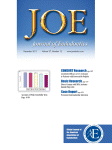Comparison among Manual Instruments and PathFile and
Mtwo Rotary Instruments to Create a Glide Path in the Root
Canal Preparation of Curved Canals
Vanessa de Oliveira Alves, DDS, MSc, Carlos Eduardo da Silveira Bueno, DDS, MSc, PhD,
Rodrigo Sanches Cunha, DDS, MSc, PhD, S ergio Luiz Pinheiro, DDS, MSc, PhD,
Carlos Eduardo Fontana, DDS, MSc, and Alexandre Sigrist de Martin, DDS, MSc, PhD
Introduction: Nickel-titanium rotary instruments
reduce procedural errors and the time required to finish
root canal preparation. The goal of this study was to
evaluate the occurrences of apical transportation and
canal aberrations produced with different instruments
used to create a glide path in the preparation of curved
root canals, namely manual K-files (Dentsply Maillefer,
Ballaigues, Switzerland) and PathFile (Dentsply Maille-
fer) and Mtwo (Sweden and Martina, Padua, Italy)
nickel-titanium rotary files. Methods: The mesial canals
of 45 mandibular first and second molars (with curva-
ture angles between 25 and 35 ) were selected for
this study. The specimens were divided randomly into
3 groups with 15 canals each, and canal preparation
was performed by an endodontist using #10-15-20
K-type stainless steel manual files (group M),
#13-16-19 PathFile rotary instruments (group PF), and
#10-15-20 Mtwo rotary instruments (group MT). The
double digital radiograph technique was used, pre-
and postinstrumentation, to assess whether apical
transportation and/or aberration in root canal
morphology occurred. The initial and final images of
the central axis of the canals were compared by super-
imposition through computerized analysis and with the
aid of magnification. The specimens were analyzed by 3
evaluators, whose calibration was checked using the
Kendall agreement test. Results: No apical transporta-
tion or aberration in root canal morphology occurred
in any of the teeth; therefore, no statistical analysis
was conducted. Conclusions: Neither the manual
instruments nor the PathFile or Mtwo rotary instruments
used to create a glide path had any influence on the
occurrence of apical transportation or produced any
canal aberration. (J Endod 2012;38:117–120)








Nenhum comentário:
Postar um comentário
Comentários